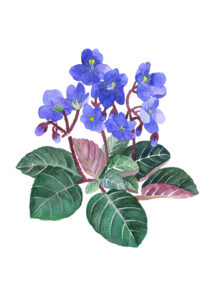 The African Violet and Stifled Potential
The African Violet and Stifled Potential
By Ella Boshart (’25)
Content Warning: this post contains references to mental illness and death.
The African violet (Saintpaulia ionantha) is said to be a symbol of devotion and faithfulness because of its unique ability to flower almost all year long. Their durability and vibrant purple blooms have rendered them one of the most popular houseplant varieties worldwide. Despite their pervasiveness in the home, these flowers that once dotted the East African mountainside, are now nearly extinct in the wild. The story of the African violet is one that hinges on exploitation, extraction, and commodification. It appears to be no accident that these stifled wild beauties appear in Sylvia Plath’s The Bell Jar, a novel that explores the oppressive reality for women in the 1950s. In her novel, Plath uses the potted African violet as a means of expressing her protagonist Esther Greenwood’s stifled creativity and feelings of suffocation.
The African violet is native to East Africa, and was “discovered” to Western botany in the Usambara Mountains 1892 by Walter von Saint Paul-Illaire. He sent seed samples back to his father who was an amateur botanist, and within a decade, “African violets had become a horticultural sensation throughout Europe” (Soderstrom 2002). Interest in African violets has certainly not died out, and they remain one of the most common houseplants globally. However, we must not forget that this botanical success story is a product of colonial plunder. While Plath may not have been fully cognizant of the intricacies of this colonial history, that history nevertheless illuminates Plath’s own understanding of the plant’s place in US society.
The Bell Jar follows a young woman named Esther Greenwood as she struggles to navigate the oppressive patriarchal system that defined 1950s USA. Esther first encounters the African violet during an important scene in the office of Jay Cee, her supervisor at a magazine internship in New York City. She admires Jay Cee and her career, while also fearing the limits put upon a woman who pursues such a professional life (Plath 2005: 39):
I sat quietly in my swivel chair for a few minutes and thought about Jay Cee. I tried to imagine what it would be like if I were Ee Gee, the famous editor, in an office full of potted rubber plants and African violets my secretary had to water each morning. I wished I had a mother like Jay Cee. Then I’d know what to do.
Here, Esther is fantasizing about escaping the uncertainty and chaos of her own life and dreaming of a life like Jay Cee’s; a life defined by order and success. In the novel, Esther struggles to navigate through life as a young female writer. She feels emotions intensely, which is what makes her so perceptive and inquisitive, but also causes her so much suffering. In New York, Esther is deprived of all natural life, she repeatedly describes the city as dead, dull, and “sunless.” The dull concrete jungle that is New York City mirrors her own, increasingly dark inner life. The African violets represent mere glimpses of nature in an otherwise barren landscape. However, there is nothing natural or wild about these plants, given that their growth is stifled and contained by the pots they are in. Like the African violet, Esther’s creativity and growth as a writer is stifled by her environment. Expectations for women in the 1950s in many ways emulated the potted African violet. Like the flower, they too were domesticated, restrained, and valued almost exclusively for their beauty.
Stifled potential is a common theme in Plath’s work, which is perhaps what drew her to the potted plant. For Plath nature represents freedom, growth, and life, which stands in contrast to her lived reality. Sylvia Plath was a woman with more drive and ambition than the world had room for. In The Bell Jar Esther also struggles to find meaning in her life. She reaches her low point when writing—her way of making sense of the world—might no longer serve as an outlet if it means sacrificing a family life. For Plath, writing was a lifeline. But like the potted African violet, her life was circumscribed. She had to fight to grow her career as a writer.
Sylvia Plath’s legacy is often limited to her sensationalized and tragic suicide, and her alleged transfixion with death. However, as we can see in relation to this African violet, such a representation of Plath and her work is much too narrow. Plath’s rich botanical imagination is a testament to her intense interest in life, and desire to live life to its fullest. Despite her challenging circumstances Plath still managed to grow a body of work so rich with life and experience which has continued to inspire and germinate feminist thought for decades. Instead of condemning Plath to a legacy defined by her mental illness and struggles, we must instead celebrate the life and care she breathed into her poetry and prose.
Works Cited
Plath, Sylvia. 2005. The Bell Jar. Princeton, NJ: Harper Perennial Modern Classics.